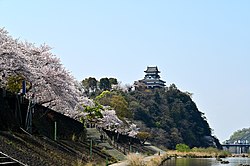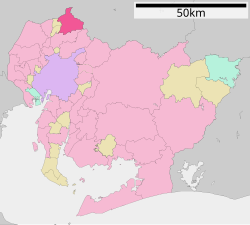This article needs additional citations for verification. (November 2015) |
Inuyama (犬山市, Inuyama-shi) is a city in Aichi Prefecture, Japan. As of 1 October 2019[update], the city had an estimated population of 73,420 in 31,276 households,[1] and a population density of 980 persons per km2. The total area of the city is 74.90 square kilometres (28.92 sq mi). The name of the city literally translates to "Dog Mountain". The name appears in historical records from 1336 AD, but its origin is unknown.
Inuyama
犬山市 | |
|---|---|
 | |
 Location of Inuyama in Aichi Prefecture | |
| Coordinates: 35°22′43″N 136°56′40.2″E / 35.37861°N 136.944500°E | |
| Country | Japan |
| Region | Chūbu (Tōkai) |
| Prefecture | Aichi |
| First official recorded | 3 BC |
| City Settled | April 1, 1954 |
| Government | |
| • Mayor | Takuro Yamada (from 2014) |
| Area | |
| • Total | 74.90 km2 (28.92 sq mi) |
| Population (October 1, 2019) | |
| • Total | 73,420 |
| • Density | 980/km2 (2,500/sq mi) |
| Time zone | UTC+9 (Japan Standard Time) |
| - Tree | Chinese hawthorn |
| - Flower | Sakura |
| Phone number | 0568-61-1800 |
| Address | 36 Higashihata, Inuyama, Inuyama-shi, Aichi-ken 484-0081 |
| Website | Official website |
Geography edit
Inuyama lies along the northwestern edge of Aichi Prefecture, separated from neighboring Gifu Prefecture by the Kiso River.
Climate edit
The city has a climate characterized by hot and humid summers, and relatively mild winters (Köppen climate classification Cfa). The average annual temperature in Inuyama is 15.1 °C. The average annual rainfall is 1910 mm with September as the wettest month. The temperatures are highest on average in August, at around 27.6 °C, and lowest in January, at around 3.4 °C.[2]
Demographics edit
Per Japanese census data,[3] the population of Inuyama has been increasing over the past 70 years.
| Year | Pop. | ±% |
|---|---|---|
| 1940 | 26,079 | — |
| 1950 | 35,145 | +34.8% |
| 1960 | 38,202 | +8.7% |
| 1970 | 50,594 | +32.4% |
| 1980 | 64,614 | +27.7% |
| 1990 | 69,801 | +8.0% |
| 2000 | 72,583 | +4.0% |
| 2010 | 75,151 | +3.5% |
Surrounding municipalities edit
History edit
Early modern period edit
The area around Inuyama was settled from prehistoric times. During the Sengoku period, part of the Battle of Komaki and Nagakute was fought in what is now Inuyama, and the Oda clan rebuilt a pre-existing fortification into Inuyama Castle.
Under the Edo period Tokugawa shogunate, Inuyama was ruled as a sub-domain of Owari Domain, entrusted to the Naruse clan, who served as senior retainers of the Nagoya-branch of the Tokugawa clan.
Late modern period edit
Immediately following the Meiji Restoration in 1868, Inuyama was established as an independent feudal han, until the 1871 abolition of the han system. With the establishment of the modern municipalities system on October 1, 1889, the town of Inuyama was created.
Contemporary history edit
Inuyama Castle was designated as a national treasure in 1935 and again in 1952.
Inuyama merged with four neighboring villages to form the city of Inuyama on April 1, 1954.
In 2016, the Inuyama Festival was proclaimed an Intangible cultural heritage by UNESCO.
Government edit
Inuyama has a mayor-council form of government with a directly elected mayor and a unicameral city legislature of 20 members. The city contributes one member to the Aichi Prefectural Assembly. In terms of national politics, the city is part of Aichi 16th district of the lower house of the Diet of Japan.
External relations edit
Twin towns – sister cities edit
International edit
- Sister cities
- Davis (California, United States of America)
- Since February 3, 2001
- Haman (South Gyeongsang Province, South Korea)
- Since February 18, 2014
- Friendship city
- Xiangyang (Hubei, China)
- Since March 3, 1983
- Sankt Goarshausen (Rhineland-Palatinate, Germany)
- Since June 1, 1992
National edit
- Sister cities
- Tateyama (Toyama Prefecture, Chūbu region)
- Since October 16, 1973
- Nichinan (Miyazaki Prefecture, Kyūshū region)
- Since August 10, 2000
- Kakamigahara (Gifu Prefecture, Chūbu region)
- Since August 23, 2011
- Tamba-Sasayama (Hyōgo Prefecture, Kansai region)
- Since April 1, 2014
Economy edit
Secondary sector of the economy edit
Ceramic engineering edit
- Inuyama ware is a type of Japanese pottery made in the town in a number of kilns.
Education edit
University edit
- National Universities
- Private Universities
Colleges edit
- Private Colleges
- Nagoya Keizai University Junior College
Schools edit
Inuyama has ten public elementary schools and four public junior high schools operated by the city government, and two public high schools operated by the Aichi Prefectural Board of Education.
Transportation edit
Railways edit
Conventional lines edit
- Inuyama Line: - Inuyamaguchi - Inuyama - Inuyama-Yūen
- Komaki Line: - Gakuden - Haguro - Inuyama
- Hiromi Line: Inuyama - Tomioka-mae - Zenjino -
Roads edit
Japan National Route edit
Local attractions edit
Castles edit
- Inuyama Castle
- ruins of Gakuden Castle
- ruins of Kinoshita Castle
Museums edit
- Meiji Mura, an open-air architectural museum for preserving and exhibiting structures of the Meiji (1867–1912) and Taishō (1913–1926) eras. As of 2005, 67 historical buildings are preserved on an area of 1,000,000 m2. The most famous one is the main entrance and lobby of Tokyo's old Imperial Hotel, designed by Frank Lloyd Wright and built in 1923.
- Little World Museum of Man, an amusement park with an anthropological museum contained a large number of buildings built according to the native style of over 22 countries.
Natural attractions edit
- The Kiso River has some very picturesque rapids upstream of Inuyama Castle. These rapids and rock formations are called the Nihon Rhine after the Rhine river in Germany, and boat tours are available. Cormorant fishing on the Kiso River is nowadays almost exclusively done for tourists.
- Japan Monkey Park has different species of monkeys and other entertainment. Inuyama is the site of the Primate Research Institute of Kyoto University,[5] one of the world's foremost centers for research in non-human primate biology and behavior. The chimpanzee Ai and her son Ayumu live there.
- Lake Iruka, a reservoir listed by the International Commission on Irrigation and Drainage as a Heritage Irrigation Structure
Other structures edit
- Urakuen tea garden, used for tea ceremonies. This garden contains the Jo-an tea house, built in 1618 by Oda Uraku (1547–1621), younger brother of Oda Nobunaga. Tea master Oda Uraku was a student of the famous tea master Sen no Rikyū. While the Jo-an tea house was originally built in Kyoto, it was moved to its current location in 1972. The building is considered one of the finest examples of tea house architecture.
- Aigi Bridge, crossing the Kiso River into Kakamigahara in Gifu Prefecture
-
Japan Monkey Park
-
Aotsuka Kofun
-
Jo-an tea house, a national treasure
Culture edit
Festival edit
- Inuyama Festival
Notable people from Inuyama edit
- Kaori Moritani, musician
- Yashiro Rokurō, admiral in the Imperial Japanese Navy
References edit
- ^ https://www.city.inuyama.aichi.jp Inuyama City official statistics] (in Japanese)
- ^ Inuyama climate data
- ^ Inuyama population statistics
- ^ "姉妹・友好都市". city.inuyama.aichi.jp (in Japanese). Inuyama. Retrieved January 7, 2021.
- ^ Monkeys use trees as catapults in escape from Kyoto Uni's primate research centre, July 7, 2010 , The Courier-Mail, Queensland Newspapers.
External links edit
- Inuyama travel guide from Wikivoyage
- Official website
- Inuyama City Tourist Association website


